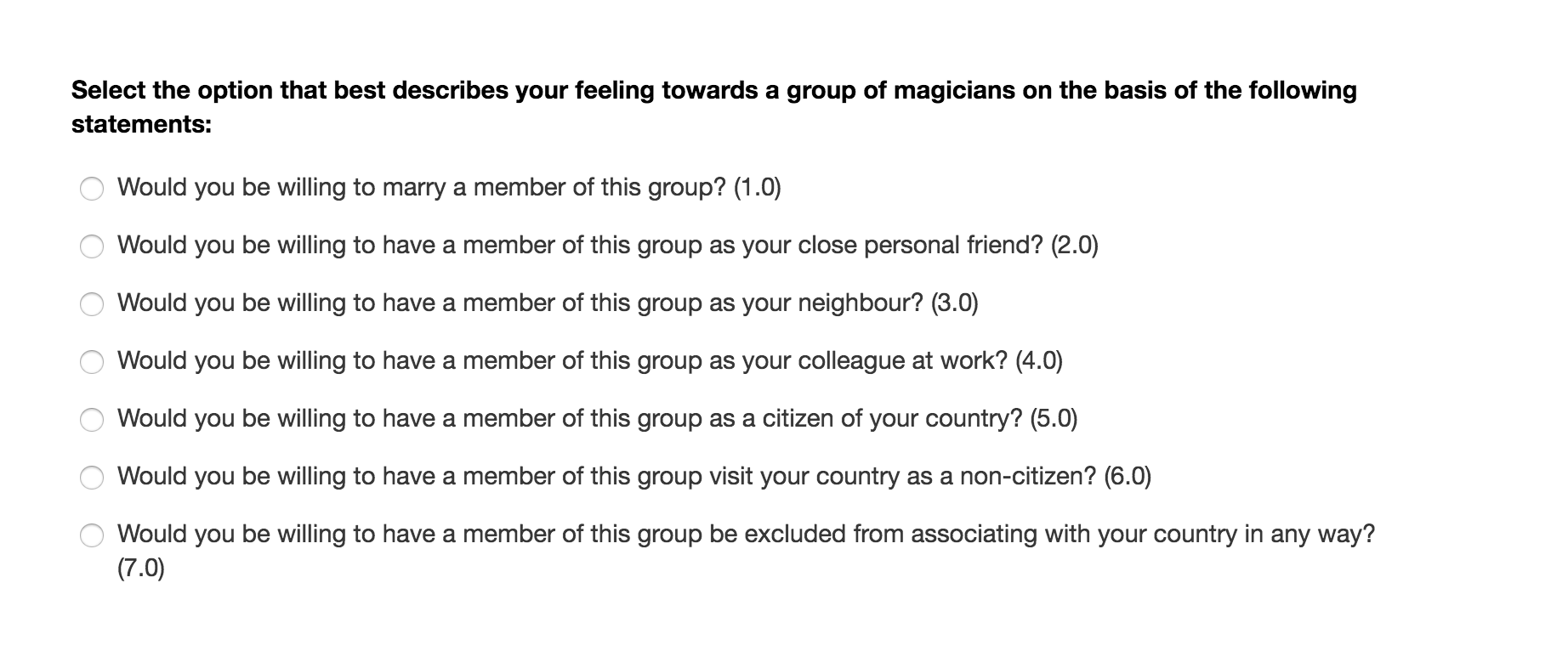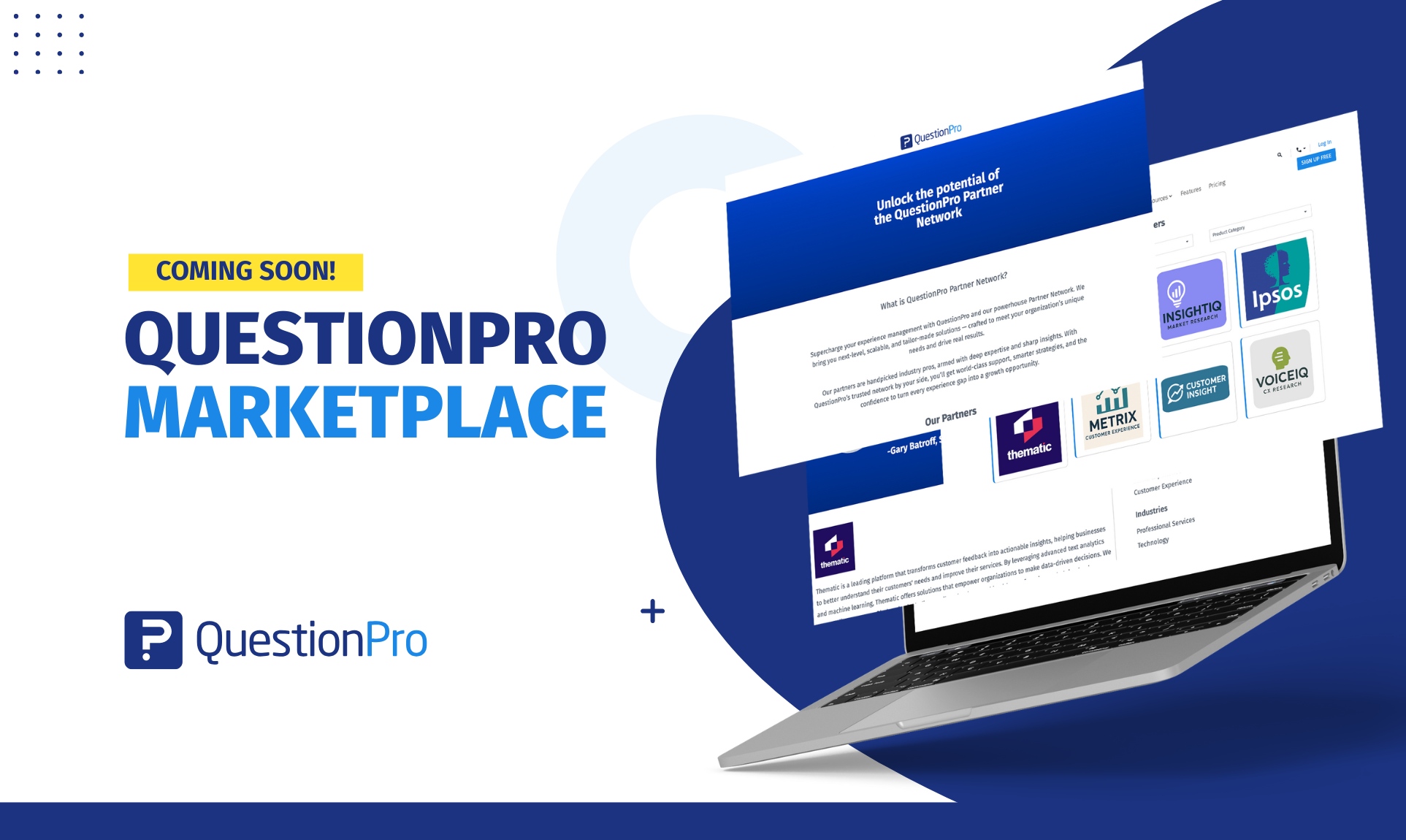
Bogardus Social Distance Scale: Definition and Example
Bogardus social distance scale is defined as a scale that measures varying degrees of closeness in people towards other members of diverse social, ethnic or racial groups. It measures the degrees of warmth, hostility, indifference or intimacy between these groups.
This scale was developed by Emory Bogardus in 1924 and named after him. It is one of the oldest and still in use, psychological attitude scales. Due to its unidimensional nature, prejudice or the lack of it towards only one community or group can be measured at one point in time. The Bogardus social distance scale is also known as a cumulative scale because an agreement with one item shows agreement with any number of preceding items; which makes it a subset of the Guttman scale. The other major types of unidimensional scales are the Likert scale and the Thurstone scale. The three major types of unidimensional scales are the Thurstone Scale, Likert Scale, and the Guttman scale. The Bogardus social distance scale is also known as a cumulative scale because an agreement with one item shows agreement with any number of preceding items; which makes it a variation of the Guttman scale.
LEARN ABOUT: System Usability Scale
For example, the Bogardus social distance scale is set up as a series of questions that ask an individual or a respondent, their feelings or the closest degree of intimacy towards a member of a group in question. A score of 1 is assigned to each option, asking the individual what the closest degree of intimacy is that he or she would be willing to admit a member of the group in question. The following is asked:
- Would you be willing to marry a member of this group? (1.0)
- Would you be willing to have a member of this group as your close personal friend? (2.0)
- Would you be willing to have a member of this group as your neighbor? (3.0)
- Would you be willing to have a member of this group as your colleague at work? (4.0)
- Would you be willing to have a member of this group as a citizen of your country? (5.0)
- Would you be willing to have a member of this group visit your country as a non-citizen? (6.0)
- Would you be willing to have a member of this group be excluded from associating with your country in any way? (7.0)
The question can be represented in the survey as:
The ratings of multiple people from one community is collected as a cumulative and the average of this number represents the value of the social distance scale.
Characteristics of the Bogardus Social Distance Scale
- Cumulative in nature: The Bogardus social distance scale is a variation of the Guttman scale (or cumulative scale) because any agreement with a statement is an assumption of agreement with any statements preceding the selection. For instance in the above example, if you were to agree to marry a magician and your rating is 1.0, it is assumed that you in effect are also agreeing to this member also being your neighbor and close personal friend or even a citizen of your country. In a similar example, if you agree for a person to be a citizen of your country (5.0), you also agree to them visiting or your country as a non-citizen or not have them be associated with your country at all.
- 7 point scale: The Bogardus social distance scale uses a 7 point social distance scale to track empathy map between 2 social groups. The lower rating 1.0 indicates a less social distance between the 2 groups whereas a higher rating like 5.0 indicates a higher social distance between the 2 groups.
- Measure social distance: The option with the rating scale 1.0 measures the proximity to a certain individual and the option with the rating scale as 7.0 measures the distance between to that individual. The Bogardus scale in brief, aims to measure the social distance which any group desires to keep with other groups/people with whom it has functional relations.
How to construct a Bogardus Social Distance Scale Survey?
A Bogardus social distance scale if conducted right, can throw light on the perception or prejudice of one group towards another. Steps in successfully conducting this survey is:
- Define the focus and research objective: Before conducting the survey, it is very important to define the focus of the research and the end objective. Since the Bogardus social distance scale helps understand the prejudice between two distinctive sets of social groups, it is important to understand the end objective. This could be on the basis of distinctive characteristics like religion, socioeconomic status or ethnicity.
- Develop the scale: The objective of the scale is to indicate how close or far away is the respondent from the members of the other group. This distance is measured by psychological statements. A favorable attitude is indicated by the closeness of the and an unfavorable attitude is indicated by the distance. The scale is then to be set up with 7 statements which consist of two anchor points – 1.0 where the favorable attitude is extreme closeness and 7.0 where the unfavorable attitude is extreme distance. Referencing the above example, marriage is indicated by 1.0 due to the nature of its closeness and not being associated with the country is indicated by 7.0 as the respondent group does not want to be associated with the other group at all.
- Developing the responses: It is important to create a number of options that have to be sent to judges or experts to rate towards the favorableness of the study. These experts have to have an in-depth understanding of sociological factors and measurements so as to appropriately validate each option. The experts are expected to rate the options yes or no depending on the validity of social distance between communities. The 7 options or statements that are highest rated are selected as the social distance scale options to be administered to the respondent. For similar-sounding options, the options with the consensus of the experts are used.
- Administer the scale to respondents: The Bogardus social distance scale is easy to administer as the question is easy to answer. It is to be explained to a respondent that an answer selection that is made means it also signifies the acceptance of all preceding options. Hence selecting 1.0 or any option close to this means an agreement of all preceding options and selecting 7.0 or an option close to this is a strong disagreement with the research topic.
- Collect response and calculate cumulatively: Each respondent has an option to select one statement in a Bogardus social distance scale where each option specifies the attitude of a member of one group towards a member or members of another group. The average of the cumulative responses is the level of social distance between the two groups. Since this scale is unidimensional, collecting social distance between multiple groups requires multiple questions to be administered.
Uses of a Bogardus Social Distance Scale
The Bogardus social distance scale survey is one of the oldest forms of methods of measuring attitude and prejudice. It can also be used to measure specific variables such as:
- Religiosity
- Socioeconomic status
- Alienation
It is used very differently across the years. Some use cases of these are:
- Traditional use: This survey has been traditionally used in understanding the psychology between two or more distinctive social groups. The was initially used in the early 19th when people extensively started moving around the globe. The scale was used to measure the social distance metrics of communities towards other immigrating communities. For example, after a Bogardus scale question survey was conducted across the mainland US, the results showed that the social distance between Canadians immigrating to the US was the lowest. The social distance between Hindus and Muslims, however, was the highest. In this case, the cumulative score of the propensity towards the Canadians was towards the 1.0 score where mainland Americans were comfortable with marrying Canadians and any preceding option. On the flip side, the scores that the Hindu and Muslim ethnicities got were towards the opposite end of the social distance scale where the cumulative consensus was that people of such ethnicities were not easily welcome to immigrate to the country.
- Modern use: A modern-day use of the Bogardus distance scale is in a work environment where the social distance prejudice is measured between existing employees of an organization and new incoming employees. The anchor scales are 1.0 where the new employee can be a part of the same team versus 7.0 where the prejudice is towards that employee not even being in the same domain. This helps measure how alienated a new employee would be in an existing workplace culture or team.
Advantages of a Bogardus Social Distance Scale
Some advantages of the Bogardus social distance scale are:
- Ease of use: The scale is very easy to create and administer. The complication could only arise in the formulating of each option in the distance scale.
- Measure prejudice: The Bogardus social distance scale measures prejudice or underlying thoughts or feelings between two separate distinctive groups of people that may range from different social groups.
- Reliable: The scale is reliable because it measures each respondent’s feelings towards a subject. The question type also ensures that each respondent selects an option.
- Ordinal levels of measurement: In this scale, ordinal data is collected from each respondent. This helps in establishing an order of preference towards the group in question.
Disadvantages of a Bogardus Social Distance Scale
Some disadvantages of the Bogardus social distance scale are:
- Ordering of options: The ordering of options can mean different things to different individuals in a group, community of family. This is on the basis of the preference of each individual member. Hence, the validity of distance in the options in a Bogardus social distance scale may not hold true for each respondent.
- Equal distance in the quantitative social distance: The distance in between two options is subjective. The distance between 3 and 4 or 6 and 7 may not be equidistant. Also, it is impossible to prove that option 6 is double the distance of 3.
- Uni-dimensional: Its nature is uni-dimensional and collects data accordingly. There is no scope to dig into the reasoning of the responses.
- Impossible to measure validity: Each member of a social group could select a response on the basis of their perception of the other group in question. But since the rating doesn’t allow to delve into the reason for selecting that rating, it is impossible to measure validity.
LEARN ABOUT: Rensis Likert and the Likert scale








